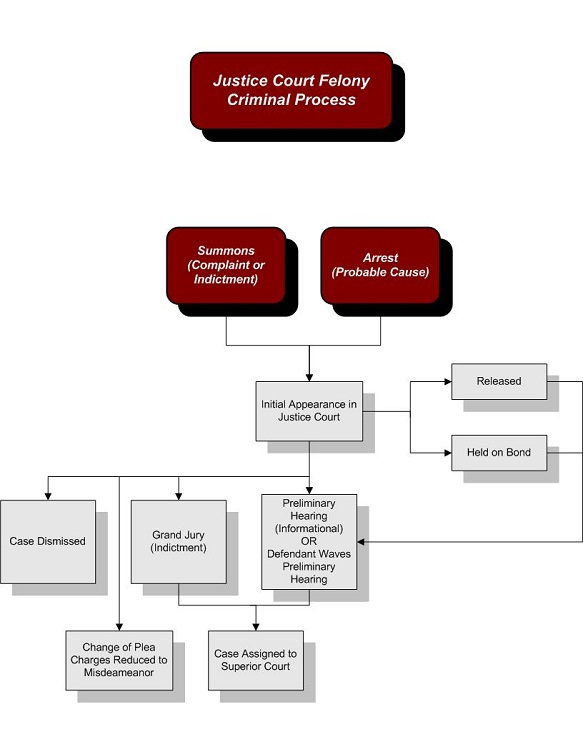Any offense punishable by death or imprisonment for more than one year is called a felony. Felonies are the most serious crimes. Here is an overview of what to expect for those charged with a felony.
- Initial Appearance
-
This is the first time a suspect appears in court. An initial appearance for a person in custody must be held within 24 hours of arrest. A summons with the date and time of the initial appearance is sent to individuals not in custody.
At the initial appearance, four important events take place:- The suspect is informed of the felony allegation(s).
- The person is advised of the right to an attorney. If the court finds the person cannot afford an attorney, one will be appointed.
- Conditions of release are established. This means the court will determine if the person shall be released on bond, on his or her own recognizance, or remain jailed for the safety of the community.
- Another court date is set for the next proceeding, usually in Justice Court or Superior Court.
- Filing Charges
-
A felony charge is initiated by a complaint or an indictment. A prosecutor files a direct complaint in court, citing which crimes were allegedly committed. An indictment is issued by a grand jury, which determines from evidence presented by a prosecutor that a crime was committed and the suspect should stand trial on the allegations. Both a direct complaint and indictment define the alleged crimes and cite the date of offense and which laws were violated.
The defendant is notified when criminally charged and informed when to appear for the next court date. A judge can issue an arrest warrant if information is presented to indicate the person will not voluntarily appear in court at the scheduled time. - Preliminary Hearing
-
A preliminary hearing is required when a felony case is initiated by a direct complaint. The prosecutor presents evidence and witnesses to try to establish probable cause that the crime was committed and the defendant should stand trial. Generally, a preliminary hearing is held in Justice Court, but it may be held in Superior Court. The judge can dismiss the case for insufficient evidence or order a trial.
- Grand Jury
-
Another method for initiating charges against a defendant is a grand jury indictment. The grand jury, comprising 16 jurors, determines whether probable cause exists based on evidence presented by the prosecutor. Grand juror proceedings are secret and their actions become public only through the indictment, if one is handed up.
- Arraignment
-
This brief Superior Court hearing is the defendant's opportunity to enter a plea to the charges. If the defendant enters a "not guilty" plea, a court date will be set. If the defendant enters a "guilty" plea, a sentencing hearing will be scheduled.
- Trial
-
In a criminal trial, the state must prove beyond a reasonable doubt that the defendant committed the crime. Superior Court juries have either eight or twelve jurors depending on the nature of the charges. A verdict must be unanimous or a mistrial can be declared and the case could be retried.
On rare occasions, instead of having a jury trial, the defendant and prosecutor agree to a bench trial and ask a judge to determine the verdict.
In a case where a not guilty verdict is reached, the charges are dismissed and the defendant cannot be retried on the same charge. This is called "double jeopardy." - Sentencing
-
A defendant who is found guilty faces a range of possible sentences for the crime. When a verdict is returned, the judge sets a sentencing date within about 30 days. At a sentencing hearing, both the defense and the prosecution can present evidence to help the judge determine an appropriate sentence. Victims have the right to address the court on what they believe would be a proper sentence.
Arizona law provides for the death penalty in first-degree murder cases in which there is an aggravating factor. Life imprisonment is also an option for murder convictions. For other crimes, the severity of the offense determines the length of sentence. Prison sentences are served in a state Department of Corrections facility. For less severe cases, a defendant may be sentenced to a term of probation. The court may impose conditions of probation that could include jail time, community service and counseling. Defendants may also be ordered to pay restitution to their victims.
